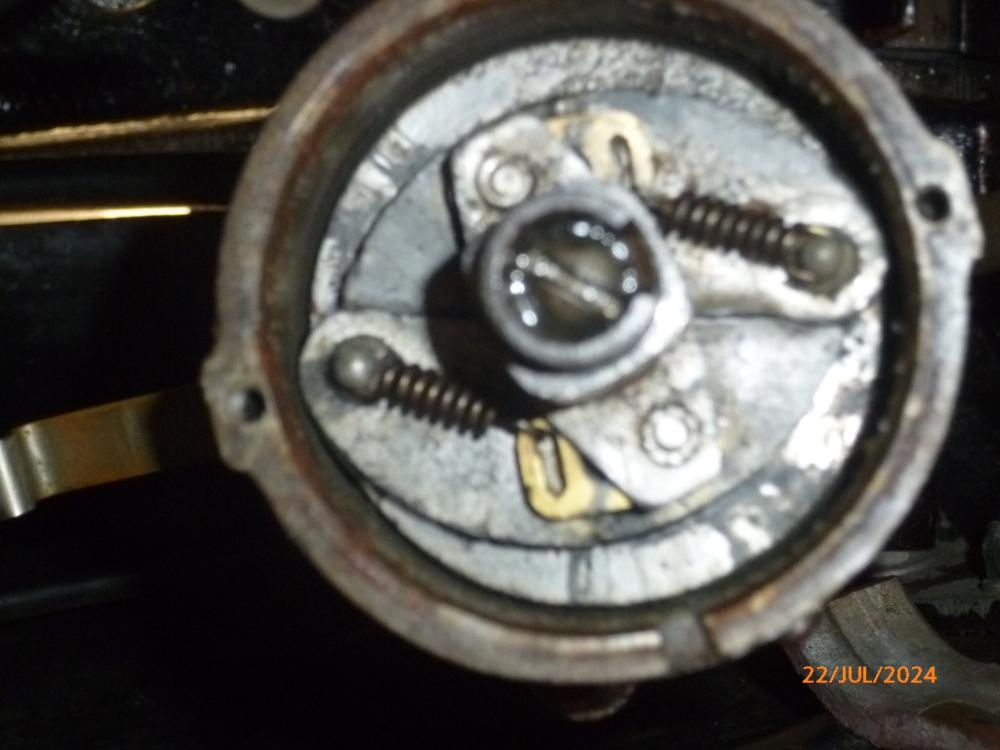Joined: Aug 2017 Posts: 663 Threads: 19
Reputation:
11
Location: Hampshire UK
Hi Chris
That's interesting - I haven't come across the slotted toggle variant before.
Checking back on my notes, the gap between the weights at full advance is about 3/16 inch (4.8 mm). The spring extension at rest is about 20 thou (0.5 mm) in other words not slack but not very stretched either.
The toggle geometry is quite clever. A plain spring acted on by centrifugal force would give an advance that increased with the square of the RPM - not what's wanted. The pivoted toggles compensate for this to give advance more or less proportional to RPM. I take my hat off to which ever mechanical designer dreamt that one up.
Joined: Aug 2017 Posts: 1,716 Threads: 47
Reputation:
25
Location: Auckland NZ
Car type: 36 Nippy, 31 RM, 38 Special, 24 Works Rep
The biggest problem with these distributers is wear in the pins of, particularly the bob weights, but also the cam, baseplate and spring anchors. Fortunately the worst of it is usually the bob weights, fortunate because new one are available, as are spring anchors and springs! if the cam base plate and spindle are badly worn you probably best to search out a better one to begin with. Spindle bearings are usually also worn, but replaceable and not normally more so than the tolerances in the new cheap electronic distributor that have been available recently. Unfortunately for us points are far more susceptible to play in the system than electronic. You could take parts from these new units to restore an original distributer, however on the ones I have examined the spindles are not hardened and the cams usually have significate slop on the spindles, so back to square one. Although you could cure a worn pin by swapping cams. parts availability or the ability to re-machine seems to be the only way to resolve the issues at present. You could fit an electronic base plate in an original distributor and see a small improvement in running, but that path requires a non original coil, plug leads and some minor wiring alteration. The positive of this path is it's cheaper than a complete new unit and looks far more original than a total swap. Of course there are many owners who will not care about any of this and just convert to modern solutions. But for my mind the vintage aspect and quirks of our cars is the appeal, the information to keep them running well as they have done for the past 100 years is there if you want it.
Black Art Enthusiast
Joined: Aug 2017 Posts: 3,477 Threads: 108
Reputation:
29
Location: Darkest Bedfordshire
You pays your money and takes your choice, but for me it's a question of searching for good units and if necessary building up one good 'un from several using the better parts - and of course taking advantage of such new parts as are available.
I take heart from the fact that some among the racing crowd used to simply disable the weights and set timing to 1 1/4" BTDC...
As an aside, I've lost count of the number of distributors I've found where new shaft bushes have been fitted but never drilled for the oiler - which begs the question how often do you oil your distributor? Perhaps it doesn't really matter...
Joined: Apr 2018 Posts: 193 Threads: 77
Reputation:
0
Thanks for all the advice so far.
I've now dismantled the rest of the advance mechanism and it basically look in fairly good condition, even the holes in the action plate aren't worn.
I phoned Distributor Doctor with the intention of ordering some new springs but he believes the toggles are wrong and actually from a DKY Type distributor. He now seems a little reluctant to supply the springs without being able to see the distributor, presumably because he can't be sure they will be OK.
He did suggest I could try closing the existing springs up as they certainly seem stretched but I find it hard to believe I could achieve this without both annealing the spring beforehand and re-heat treating it afterwards.
So, firstly is there any other possible supply for springs, and secondly is anyone able to measure the overall dimension between the holes on the toggles which have two holes rather than a slot so I can compare this with the slot length on mine?
Many thanks,
John.
Joined: Aug 2017 Posts: 3,477 Threads: 108
Reputation:
29
Location: Darkest Bedfordshire
John I'm still wondering which distributor that was whose photo I posted above - but I think it was a DK4A body fitted with the shaft & associated bits from from a later DKHY distributor. The DKHY has a high-lift cam so the points gap is set a bit wider (14-16 thou). Advance was 8 1/2 degrees. I will try & remember tomorrow which car I fitted it to! If DD is declining to supply I should ask him why he feels they wouldn't work OK... or just tell him you found a DK4A and try them for yourself.






